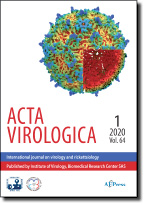Acta Virologica Vol.61, No.2, p.150-160, 2017
|
| Title: Combination of H120 and 1/96 avian infectious bronchitis virus vaccine strains protect chickens against challenge with IS/1494/06 (variant 2)-like infectious bronchitis virus |
| Author: M. HABIBI, V. KARIMI, A. G. LANGEROUDI, S. A. GHAFOURI, M. HASHEMZADEH, R. K. FARAHANI, H. MAGHSOUDLOO, H. ABDOLLAHI, P. SEIFOURI |
|
Abstract: Avian infectious bronchitis (IB) is a worldwide chicken disease, caused by avian infectious bronchitis virus (IBV) which infects all commercial poultry lines. The present study was done to evaluate protection caused by two different serotype vaccines (Massachusetts and 793/B) in order to evaluate protection against challenge with IS/1494/06-like virus (variant 2-like virus), which is prevalent in the Middle East. SPF chickens were divided into four groups (n = 20). First and second group as negative control group and non-vaccinated-challenged group received no vaccine. Groups 3 and 4 received H120-H120 and H120-1/96 IBV vaccine strains at the 1st and 14th day, respectively. Twenty one days after last vaccination, non-vaccinated-challenged group and vaccinated group were challenged using variant 2-like IBV. Serum samples were collected before challenge to measure humoral immune response of chickens. Five days after challenge, the tissue samples from the trachea, lungs and kidneys were taken to evaluate cilliary activity, viral load (quantitative real-time RT-PCR), and histopathological evaluation. Clinical sign scores were also recorded after challenge. Overall, the results showed a protective efficacy of the used vaccination program. Best cross protection (69.2%) was obtained in the H120-1/96 vaccinated group. Virus replication of the challenged virus in H120-1/96 group compared with H120-H120 group showed a significant reduction of viral load in trachea (1.5×103 compared to 503) and kidneys. Clinical sign scores of the challenged groups showed significant effect of the vaccination program to reduce clinical signs. The trachea pathological scores and histopathological findings in the lungs and kidneys also confirmed better protective efficacy of vaccinated groups. In conclusion, using combination of heterologous IBV vaccine serotypes (Massachusetts and 793/B) would be a better strategy to control variant 2-like viruses, but more evaluation is needed using other circulating isolates to find the best combination of vaccines.
|
|
| Keywords: avian infectious bronchitis; vaccination; cross protection; 1/96 strain |
|
|
Published online: 19-May-2017
|
| Year: 2017, Volume: 61, Issue: 2 |
Page From: 150, Page To: 160 |
doi:10.4149/av_2017_02_04
|
|
 download file download file |
|
|
|
|
 download file
download file
